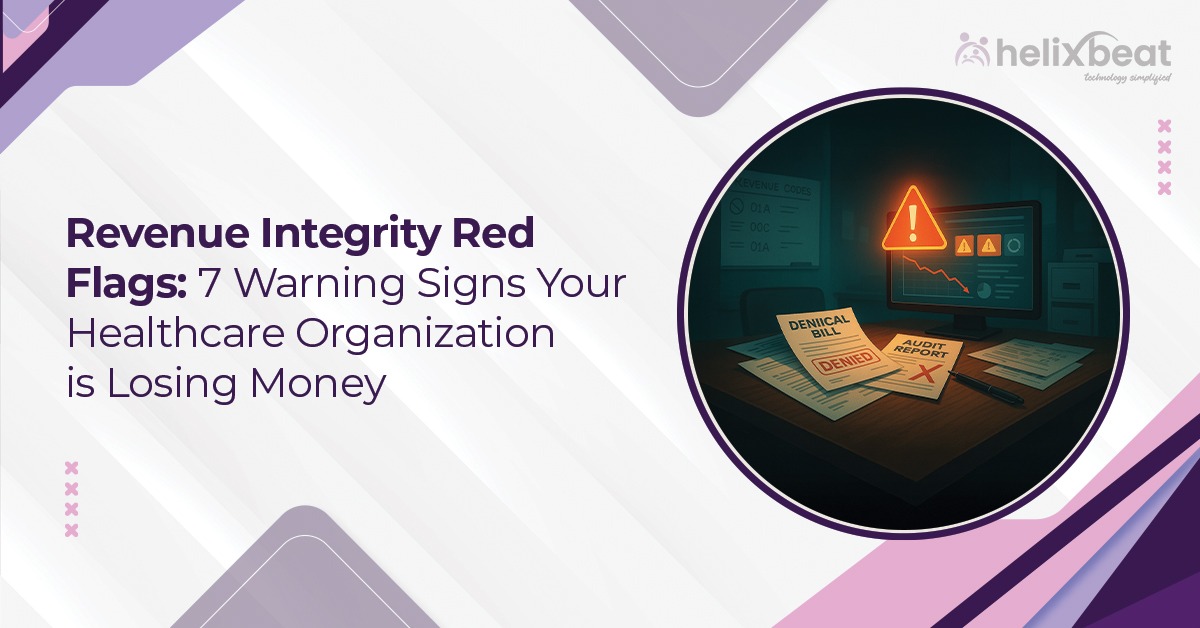In healthcare, maintaining strong revenue integrity is key to staying financially healthy. However, despite the best efforts, there are often hidden signs that things aren’t running smoothly. Recognizing these early warning signs can prevent major financial setbacks.
In this blog, we’ll highlight seven key red flags that could signal your healthcare organization is losing money. By identifying these issues early, you can take action to fix them before they turn into bigger problems.

Table of Contents
1. Consistent Claim Denials and Delays
One of the most obvious signs that something is wrong with your revenue integrity is a high rate of claim denials and delays. If your organization consistently faces denied or delayed claims, it could point to errors in coding, incomplete documentation, or billing issues that need immediate attention.
While a few denials are normal in any healthcare setting, an unusually high rate can be costly. Additionally, delays in claims processing can extend cash flow cycles and cause financial instability.
2. Unexplained Drop in Reimbursement Rates
If you notice a sudden drop in reimbursement rates from payers, it could indicate inefficiencies or mistakes in billing and coding practices. Often, insurance companies will reduce reimbursement rates if they find discrepancies or incorrect coding in claims. When reimbursements are lower than expected, it can affect the bottom line and, over time, erode an organization’s financial health.
This could also indicate that payer contracts aren’t being managed effectively or that negotiated rates aren’t being followed. Discrepancies in contract management are often a hidden cause of revenue loss, further threatening revenue integrity in healthcare.
3. High Rate of Upcoding and Underreporting
Revenue integrity is heavily reliant on proper documentation and coding practices. Therefore, one of the major red flags for healthcare organizations is the presence of upcoding or underreporting.
Upcoding occurs when a provider submits a code that represents a higher level of service than what was actually provided. On the other hand, underreporting happens when a provider submits a code for a lower level of service, which can reduce the reimbursement rate. Both practices can significantly damage your revenue cycle and lead to compliance issues.
Although upcoding might seem like a quick way to increase revenue, it’s a risky practice that can lead to audits, fines, and damage to a healthcare organization’s reputation.
4. Inefficient Charge Capture Processes
Charge capture refers to the process by which healthcare providers document and submit charges for services rendered. Inefficient charge capture can result in missed charges, unbilled services, and ultimately, lost revenue. This issue is particularly common in large organizations with multiple departments and service lines.
If your charge capture process is disorganized or relies on manual data entry, there’s a high chance of errors that affect revenue. This inefficiency can also lead to the failure to capture certain services or procedures provided, which means money is left on the table.
5. Lack of Revenue Cycle Transparency
A lack of transparency in the revenue cycle is another big indicator that revenue integrity is at risk. When healthcare organizations fail to have clear, transparent processes for managing revenue, it becomes difficult to track the progress of claims, identify inefficiencies, or pinpoint bottlenecks.
Without transparency, it’s easy to overlook issues like unprocessed claims, billing errors, or payer discrepancies. These gaps in visibility can lead to delayed payments, lost revenue, and compliance risks.
6. Inconsistent Patient Financial Responsibility
Patients today are expected to shoulder more financial responsibility for their healthcare services, often in the form of high-deductible health plans, co-pays, and co-insurance. If your organization is struggling with inconsistent patient collections or high rates of bad debt, it’s a sign that the revenue integrity process needs an overhaul.
An organization might be losing money if it fails to collect payments upfront or provides unclear billing statements to patients. Inconsistent patient financial responsibility can lead to delays in payments, incomplete collections, or total write-offs, negatively impacting revenue.
7. Failure to Address Compliance Issues
Compliance with healthcare regulations is critical to maintaining revenue integrity. Healthcare organizations that fail to meet regulatory requirements, such as HIPAA or billing compliance standards, are at risk of facing audits, fines, or legal penalties that can be financially devastating. Non-compliance with payer policies and government programs can also lead to delayed reimbursements or lost revenue.
Failure to comply with both internal and external guidelines may stem from a lack of formal training, poor oversight, or inadequate systems for ensuring adherence to rules.
| Red Flag | Description | Impact on Revenue |
| 1. Consistent Claim Denials and Delays | High rates of denied or delayed claims, often due to coding errors, incomplete documentation, or billing issues. | Extends cash flow cycles and causes financial instability. |
| 2. Unexplained Drop in Reimbursement Rates | A sudden decrease in reimbursement rates from payers due to discrepancies or incorrect coding, or poor contract management. | Erodes financial health and affects the bottom line. |
| 3. High Rate of Upcoding and Underreporting | Upcoding (submitting higher service codes) or underreporting (submitting lower service codes) that damages revenue integrity and may lead to compliance issues. | Risks audits, fines, and damaged reputation. |
| 4. Inefficient Charge Capture Processes | Disorganized or manual charge capture processes leading to missed charges and unbilled services. | Results in lost revenue and missed opportunities for billing. |
| 5. Lack of Revenue Cycle Transparency | A lack of clear processes for tracking claims, identifying inefficiencies, or spotting bottlenecks. | Leads to delayed payments, lost revenue, and compliance risks. |
| 6. Inconsistent Patient Financial Responsibility | Difficulty collecting upfront payments or providing unclear billing statements to patients, resulting in high rates of bad debt. | Causes delays in payments, incomplete collections, or write-offs. |
| 7. Failure to Address Compliance Issues | Failing to comply with healthcare regulations, such as HIPAA, billing standards, or payer policies, which can lead to audits, fines, and delayed reimbursements. | Financial penalties and delayed reimbursements. |
How Helixbeat Can Help You Maintain Revenue Integrity
Helixbeat provides a comprehensive suite of services that streamline your revenue cycle management and prevent financial losses. Here’s how we can help:
1. Patient Registration & Eligibility Verification
By collecting precise data from the outset, we minimize the possibility of errors in billing, thereby making the entire process more efficient.
2. Medical Coding & Billing
Our expert coding services follow the latest coding standards (ICD-10-CM, CPT, HCPCS) to guarantee accurate and compliant claims submissions. This minimizes the risk of rejected claims and delays in reimbursement.
3. Claims Management
Helixbeat provides end-to-end claims submission and tracking services. We handle proactive follow-ups with payers, reducing the chance of missed payments or rejected claims. Our denial management strategies focus on maximizing reimbursements, helping healthcare organizations receive the revenue they’re entitled to.
4. Accounts Receivable (AR) Management
With our AR management, organizations can effectively manage outstanding claims and payments. By streamlining workflows and following up on overdue accounts, we help reduce aging balances and improve cash flow.
5. Denials Management
Our dedicated Denials Management team works to resolve denied claims quickly. They perform thorough root cause analysis, conduct proactive appeals, and track claims in real-time, all while maintaining compliance with industry standards. This helps to maximize reimbursements and minimize lost revenue.
6. Compliance & Regulatory Management
Helixbeat supports compliance with healthcare regulations, including HIPAA and payer contracts, by offering expert assistance, internal controls, and audits. This reduces the risk of non-compliance and ensures that your organization stays on top of industry standards and regulatory changes.
Final Thoughts
The healthcare industry is inherently complex, with many moving parts that can impact revenue generation. If your organization is experiencing one or more of these warning signs, it may be time to reevaluate your revenue cycle management practices.
By partnering with Helixbeat, healthcare organizations can tackle the red flags that lead to revenue loss. Contact us today to discover better patient experiences, improve provider satisfaction, and sustain long-term growth.
FAQs
1. What are the most common revenue integrity red flags?
Common revenue integrity red flags include high claim denials, inconsistent reimbursement rates, upcoding or underreporting, inefficient charge capture processes, lack of transparency in the revenue cycle, inconsistent patient financial responsibility, and failure to address compliance issues.
2. How can Helixbeat help reduce claim denials?
Helixbeat minimizes claim denials by offering accurate patient registration, real-time insurance verification, and expert medical coding and billing services. This ensures that all details are correct from the start, reducing the chances of rejected claims.
3. What is charge capture, and why is it important for revenue integrity?
Charge capture refers to the process of documenting and submitting charges for services provided. Efficient charge capture ensures that all services are properly billed, reducing missed charges and preventing revenue loss.
4. What is accounts receivable (AR) management, and how does it impact revenue?
AR management involves managing outstanding claims and payments. Effective AR management helps reduce aging balances, improve cash flow, and minimize delays in revenue collection, contributing to financial stability.
5. What types of financial reporting does Helixbeat provide?
Helixbeat offers real-time dashboards and customizable reports that provide insights into key performance indicators (KPIs), claim statuses, and overall revenue. This data helps healthcare organizations optimize their revenue cycle management.














